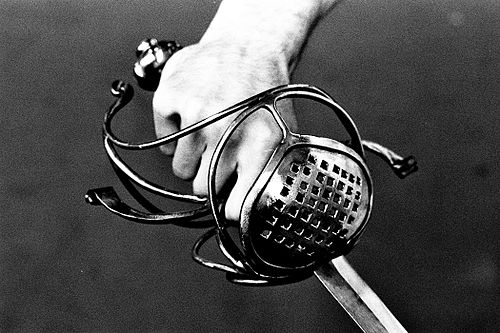Longswordnoun
Any type of sword that is comparatively long; depending on context, applied to swords of the Bronze Age, Migration period, Viking Age and Renaissance era.
Longswordnoun
A European sword with a long, straight double-edged blade, a cruciform hilt, and a grip for two-handed use; prevalent from the 14th to 16th centuries.
Longswordnoun
A sword with a long blade, especially one designed to be used with two hands.
Longswordnoun
Usually with capital initial. (An epithet of) William, third earl of Salisbury (1167–1226), the illegitimate son of King Henry II of England and Ida de Tosny, and his son, also named William (1209–50).
Longsword
A longsword (also spelled as long sword or long-sword) is a type of European sword characterized as having a cruciform hilt with a grip for two-handed use (around 16 to 28 cm or 6 to 11 in), a straight double-edged blade of around 85 to 110 cm (33 to 43 in), and weighing approximately 1 to 1.5 kg (2 lb 3 oz to 3 lb 5 oz).The type exists in a morphological continuum with the medieval knightly sword and the Renaissance-era Zweihänder. It was prevalent during the late medieval and Renaissance periods (approximately 1350 to 1550), with early and late use reaching into the 12th and 17th centuries.
Rapiernoun
A slender, straight, sharply pointed sword (double-edged, single-edged or edgeless).
Rapieradjective
Extremely sharp.
Rapieradjective
Cutting smarts or keen wit.
Rapiernoun
A straight sword, with a narrow and finely pointed blade, used only for thrusting.
Rapiernoun
a straight sword with a narrow blade and two edges
Rapier
A rapier () or espada ropera is a type of sword with a slender and sharply-pointed two-edged blade that was popular in Western Europe, both for civilian use (dueling and self-defense) and as a military side arm, throughout the 16th and 17th centuries. Important sources for rapier fencing include the Italian Bolognese group, with early representatives such as Antonio Manciolino and Achille Marozzo publishing in the 1530s, and reaching the peak of its popularity with writers of the early 1600s (Salvator Fabris, Ridolfo Capo Ferro).




















